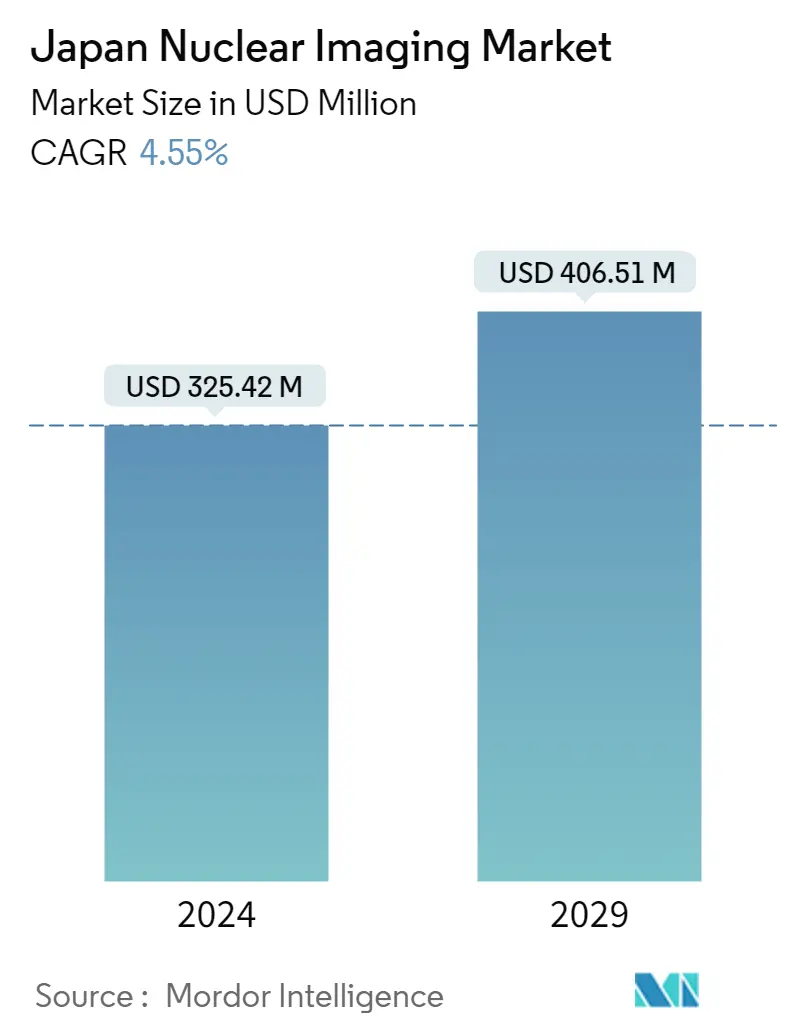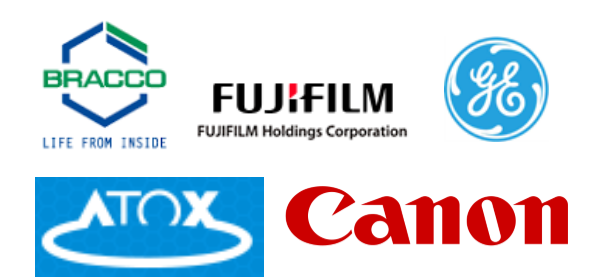
| Study Period | 2019 - 2029 |
| Base Year For Estimation | 2023 |
| Forecast Data Period | 2024 - 2029 |
| Historical Data Period | 2019 - 2022 |
| Market Size (2024) | USD 325.42 Million |
| Market Size (2029) | USD 406.51 Million |
| CAGR (2024 - 2029) | 4.55 % |
Major Players
*Disclaimer: Major Players sorted in no particular order |
Japan Nuclear Imaging Market Analysis
The Japan Nuclear Imaging Market size is estimated at USD 325.42 million in 2024, and is expected to reach USD 406.51 million by 2029, growing at a CAGR of 4.55% during the forecast period (2024-2029).
Certain factors that are driving the market growth include the rise in prevalence of cancer and cardiac disorders, increase in technological advancements, growth in the applications of nuclear medicine and imaging.
After being ranked the topmost cause of life-loss in the last century, stroke is now the third-ranked cause of death in Japan, following cancer and heart disease. According to the 2018 article, 'Lifestyle and cardiovascular disease in Japan', the recent trend of rising CHD (coronary heart disease) prevalence among the urban population is a cause for serious concern, as a potential source of forthcoming problems for public health as well as clinical practice in Japan. Moreover, due to the association between lifestyle and CVD (cardiovascular disease), higher sodium, lower calcium, and lower animal protein content in the diet, along with higher alcohol consumption, may account for the higher prevalence of hypertension and higher risk of stroke in the Japanese population than for western population at same BMI levels. According to the latest OECD data, in Japan, patients with end-stage kidney failure (ESKF), often caused by diabetes and hypertension, are the highest in the OECD at 238 per 100,000 population while the average is 101. Thus, the increasing prevalence of cancer, along with certain cardiovascular diseases, is expected to propel the growth of the nuclear imaging market in Japan.
Japan Nuclear Imaging Industry Segmentation
As per the scope of the report, nuclear medicine imaging procedures are non-invasive, with the exception of intravenous injections, and are usually painless medical tests that help physicians diagnose and evaluate medical conditions. These imaging scans use radioactive materials called radiopharmaceuticals or radiotracers. These radiopharmaceuticals are used in diagnosis and therapeutics. They are small substances that contain a radioactive substance that is used in the treatment of cancer and cardiac and neurological disorders.
The Japanese Nuclear Imaging Market is Segmented by Product (Equipment and Radioisotope (SPECT Radioisotopes (Technetium-99m (TC-99m), Thallium-201 (TI-201), Gallium (Ga-67), Iodine (I-123), and Other SPECT Radioisotopes) and PET Radioisotopes (Fluorine-18 (F-18), Rubidium-82 (RB-82), and Other PET Radioisotopes), Application (SPECT Applications (Orthopedics, Thyroid, Cardiology, and Other SPECT Applications) and PET Applications (Oncology, Oncology, Neurology, and Other PET Applications). The report offers the value (in USD million) for the above segments.
| Equipment | |||
| Radioisotope | SPECT Radioisotopes | Technetium-99m (TC-99m) | |
| Thallium-201 (TI-201) | |||
| Gallium (Ga-67) | |||
| Iodine (I-123) | |||
| Other SPECT Radioisotopes | |||
| PET Radioisotopes | Fluorine-18 (F-18) | ||
| Rubidium-82 (RB-82) | |||
| Other PET Radioisotopes | |||
| SPECT Applications | Orthopedics |
| Thyroid | |
| Cardiology | |
| Other SPECT Applications | |
| PET Applications | Oncology |
| Cardiology | |
| Neurology | |
| Other PET Applications |
Japan Nuclear Imaging Market Size Summary
The Japan Nuclear Imaging Devices Market is poised for growth, driven by the increasing prevalence of cancer and cardiovascular diseases, alongside advancements in technology and the expanding applications of nuclear medicine. The market is expected to experience a steady rise over the forecast period, supported by the growing demand for early diagnostics and treatment options. The oncology segment, in particular, is anticipated to capture a significant share due to the rising burden of cancer and the enhanced use of radioisotopes for diagnosis and treatment. The integration of artificial intelligence in nuclear medicine is further expected to bolster market growth by improving diagnostic accuracy and treatment planning.
The market landscape is characterized by moderate competition, with key players such as ATOX CO. Ltd, Bracco Imaging SpA, CANON INC., and GE Healthcare actively participating in strategic collaborations and technological advancements. These companies are focusing on expanding their product offerings and enhancing their research and development capabilities to meet the growing demand for nuclear imaging devices. The increasing number of chronic diseases and the need for effective diagnostic tools are driving the demand for nuclear imaging equipment across various medical applications, including cardiology and orthopedics. As a result, the market is set to expand, supported by both technological innovations and strategic partnerships among industry players.
Japan Nuclear Imaging Market Size - Table of Contents
1. MARKET DYNAMICS
- 1.1 Market Overview
-
1.2 Market Drivers
- 1.2.1 Rise in Prevalence of Cancer and Cardiac Disorders
- 1.2.2 Increase in Technological Advancements
- 1.2.3 Growth in the Applications of Nuclear Medicine and Imaging
-
1.3 Market Restraints
- 1.3.1 High Cost of Techniques
- 1.3.2 Short Half-life of Radiopharmaceuticals
-
1.4 Porter's Five Forces Analysis
- 1.4.1 Threat of New Entrants
- 1.4.2 Bargaining Power of Buyers/Consumers
- 1.4.3 Bargaining Power of Suppliers
- 1.4.4 Threat of Substitute Products
- 1.4.5 Intensity of Competitive Rivalry
2. MARKET SEGMENTATION (Market Size by Value - USD Million)
-
2.1 Product
- 2.1.1 Equipment
- 2.1.2 Radioisotope
- 2.1.2.1 SPECT Radioisotopes
- 2.1.2.1.1 Technetium-99m (TC-99m)
- 2.1.2.1.2 Thallium-201 (TI-201)
- 2.1.2.1.3 Gallium (Ga-67)
- 2.1.2.1.4 Iodine (I-123)
- 2.1.2.1.5 Other SPECT Radioisotopes
- 2.1.2.2 PET Radioisotopes
- 2.1.2.2.1 Fluorine-18 (F-18)
- 2.1.2.2.2 Rubidium-82 (RB-82)
- 2.1.2.2.3 Other PET Radioisotopes
-
2.2 Application
- 2.2.1 SPECT Applications
- 2.2.1.1 Orthopedics
- 2.2.1.2 Thyroid
- 2.2.1.3 Cardiology
- 2.2.1.4 Other SPECT Applications
- 2.2.2 PET Applications
- 2.2.2.1 Oncology
- 2.2.2.2 Cardiology
- 2.2.2.3 Neurology
- 2.2.2.4 Other PET Applications
Japan Nuclear Imaging Market Research FAQs
How big is the Japan Nuclear Imaging Market?
The Japan Nuclear Imaging Market size is expected to reach USD 340.23 million in 2025 and grow at a CAGR of 4.55% to reach USD 425.00 million by 2030.
What is the current Japan Nuclear Imaging Market size?
In 2025, the Japan Nuclear Imaging Market size is expected to reach USD 340.23 million.


